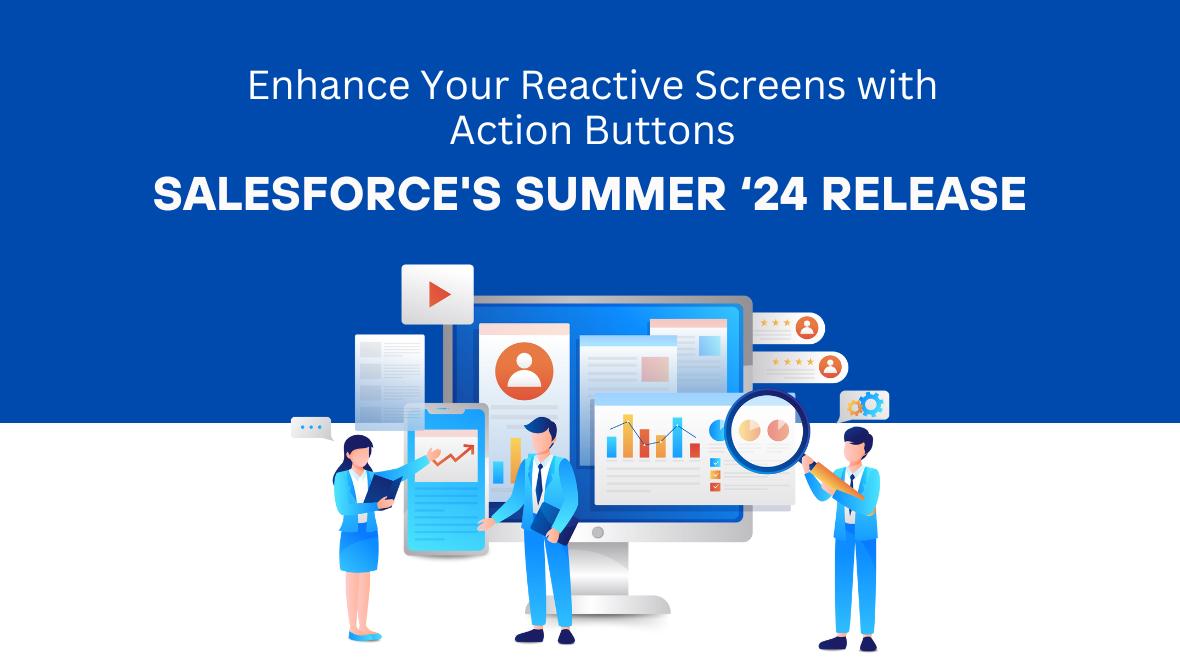In the dynamic landscape of application development, the pursuit of creating intuitive and responsive user interfaces remains paramount. Salesforce, a leader in customer relationship management solutions, continues to push the boundaries with its latest innovation: Action Buttons. In this blog post, we’ll explore how Action Buttons elevate the reactivity of screens, enabling developers to craft truly dynamic single-page applications.
Unleashing the Power of Reactivity
With the introduction of Action Buttons, developers gain a versatile tool to amplify the interactivity of their applications. These buttons seamlessly integrate with autolaunched flows, empowering them to retrieve and manipulate data, all within the confines of a single screen. This capability unlocks a myriad of use cases, revolutionizing the way users interact with Salesforce applications.
Elevating User Experience
Imagine a scenario where a user selects an account and expects to see related records—be it cases, contacts, or opportunities—without navigating away from the current screen. Action Buttons, powered by Flow, make this seamless transition a reality. By configuring the Action Button component, developers can effortlessly orchestrate the retrieval of pertinent data and present it in a cohesive manner, keeping users engaged and focused.
Realizing Versatile Use Cases
The versatility of Action Buttons transcends traditional boundaries, offering developers a plethora of use cases to explore:
- Dynamic Data Presentation: Generate data tables or sets of radio options based on selected parent records, facilitating streamlined data visualization.
- Integration with External Systems: Retrieve product data from external systems and seamlessly integrate it into the Salesforce environment for user selection.
- Dependent Picklist Fields: Create dynamically dependent picklist fields based on record data, enhancing the user experience by offering tailored selections.
- Summarizing Record Selections: Provide users with summarized insights, such as minimum dates, total amounts, or related record details, all within the confines of a single screen.
Configuration Made Simple
Configuring an Action Button is intuitive and straightforward. By dragging the Action Button component into the screen editor, labeling it appropriately, and selecting an active autolaunched flow, developers lay the foundation for enhanced reactivity. Furthermore, configuring inputs into the autolaunched flow mirrors the familiar process of setting up subflows, ensuring a seamless transition for developers.
Enabling Richer, More Dynamic Screens
Once configured, Action Buttons empower developers to access the results of their actions anywhere on the screen. This flexibility enables the creation of richer, more dynamic screens, where data flows seamlessly and user interactions are fluid. Whether it’s populating a data table with dynamically generated case data or presenting summarized record selections, the possibilities are endless.
Embracing the Future of Application Development
As Salesforce continues to innovate, Action Buttons stand as a testament to the company’s commitment to empowering developers and enhancing user experiences. By embracing reactivity and enabling seamless data manipulation, Salesforce paves the way for a new era of application development—one where agility, responsiveness, and user-centric design reign supreme.
In conclusion, Action Buttons represent a paradigm shift in the way developers approach screen reactivity. By harnessing the power of Flow-powered actions, Salesforce empowers developers to create truly dynamic single-page applications that redefine user expectations. As we eagerly anticipate the next release, the future of application development has never looked brighter.
Reference – https://admin.salesforce.com/blog/2024/flow-enhancements-summer-24-be-release-ready


